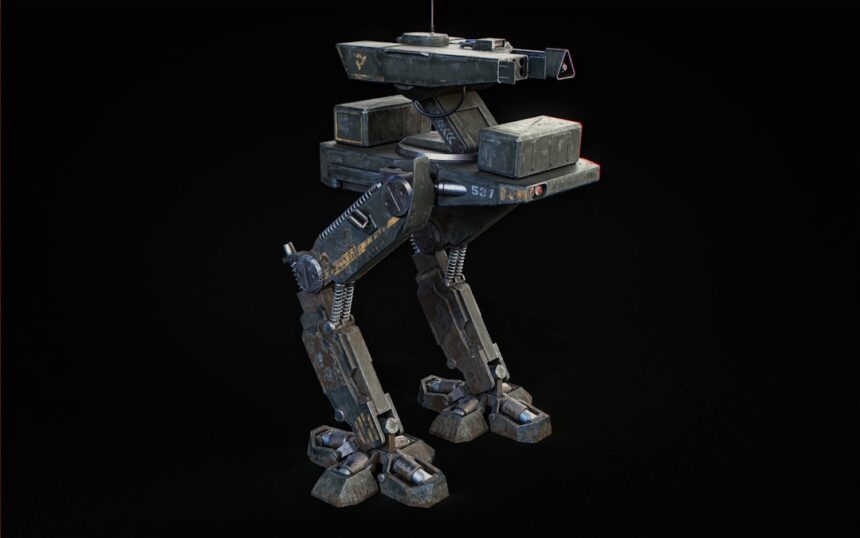The concept of unmanned warfare has undergone a remarkable transformation over the centuries, evolving from rudimentary mechanical devices to sophisticated technologies that dominate modern battlefields. Initially, the idea of conducting warfare without direct human involvement was limited to simple contraptions, such as catapults and siege engines, which operated on principles of physics rather than automation. As technology advanced, so did the complexity and capability of unmanned systems.
The 20th century marked a significant turning point with the advent of radio-controlled devices and early drones, which began to change the landscape of military operations. In recent decades, the evolution of unmanned warfare has accelerated dramatically, driven by advancements in robotics, artificial intelligence, and sensor technology. Today’s drones are not merely tools for surveillance; they are equipped with precision strike capabilities that allow for targeted attacks with minimal collateral damage.
This evolution reflects a broader trend in military strategy, where the emphasis has shifted towards remote engagement and minimizing risk to personnel. As nations continue to invest in unmanned systems, the implications for future conflicts and military doctrines become increasingly profound.
Key Takeaways
- Unmanned warfare has evolved from ancient times to the modern era, with the use of drones and other unmanned technologies becoming increasingly prevalent in military strategy.
- Historical precedents for drone tactics can be found in ancient and medieval warfare, where various forms of unmanned warfare were utilized for reconnaissance, communication, and even offensive purposes.
- Unmanned warfare in ancient times included the use of early forms of unmanned technologies such as the Chinese “divine machines” and the Greek “automatic defenders” for defensive and offensive purposes.
- Unmanned warfare in the Middle Ages saw the use of early forms of unmanned technologies such as the Byzantine “Greek fire” and the use of unmanned siege weapons for military advantage.
- Unmanned warfare in the modern era has seen the rise of aerial drones, which have revolutionized military reconnaissance, surveillance, and targeted strikes, leading to significant changes in military strategy and tactics.
Historical Precedents for Drone Tactics
The historical precedents for drone tactics can be traced back to various innovative military strategies that sought to leverage technology for combat advantages. One of the earliest examples can be found in World War I, where the use of aerial reconnaissance began to take shape. Although these early aircraft were piloted, they laid the groundwork for the concept of using the skies for intelligence gathering without direct engagement.
The lessons learned during this period would later inform the development of unmanned aerial vehicles (UAVs) in subsequent conflicts. Moreover, World War II saw the introduction of more advanced technologies that hinted at the future of unmanned warfare. The Germans developed the V-1 flying bomb, an early cruise missile that could be launched from a distance to strike targets without risking a pilot’s life.
This marked a significant step towards autonomous weaponry, demonstrating that warfare could be conducted remotely with devastating effects. These historical precedents illustrate how military innovation has consistently sought to reduce human risk while enhancing operational effectiveness.
Unmanned Warfare in Ancient Times

Unmanned warfare is not a modern invention; its roots can be traced back to ancient civilizations that employed various forms of remote engagement in battle. One notable example is the use of incendiary devices in ancient Greece and Rome. During sieges, armies would launch flaming projectiles over city walls using catapults or ballistae, effectively attacking enemy fortifications without direct confrontation.
These early forms of unmanned tactics showcased the ingenuity of military strategists who sought to maximize their impact while minimizing exposure to enemy fire. Additionally, ancient Chinese military texts describe the use of “fire arrows,” which were essentially early forms of rockets designed to strike targets from a distance. These devices were often used in conjunction with psychological warfare tactics, as their unpredictable nature could instill fear in enemy troops.
Such historical instances highlight that the principles of unmanned warfare—striking from a distance and reducing risk—have been integral to military strategy for millennia.
Unmanned Warfare in the Middle Ages
| Weapon | Usage | Effectiveness |
|---|---|---|
| Fire arrows | Used in sieges and naval warfare | Effective in causing chaos and destruction |
| Early explosive devices | Deployed against enemy fortifications | Varied effectiveness depending on design and deployment |
| Automata | Used for psychological warfare and distraction | Effective in creating fear and confusion |
The Middle Ages witnessed further developments in unmanned warfare tactics, particularly with the advent of siege engines and artillery. The introduction of trebuchets and cannons allowed armies to bombard enemy fortifications from afar, effectively changing the dynamics of siege warfare. These machines operated without direct human involvement at the point of impact, allowing for strategic advantages while keeping soldiers at a safer distance from enemy defenses.
Moreover, during this period, the use of naval warfare also began to incorporate unmanned tactics. The deployment of fire ships—vessels set ablaze and sent into enemy fleets—was a tactic employed by various naval powers. These ships acted as unmanned weapons, creating chaos and destruction without risking sailors’ lives in direct combat.
The Middle Ages thus marked a significant era in which military leaders began to recognize the potential of unmanned systems to alter the course of battles.
Unmanned Warfare in the Modern Era
The modern era has seen an exponential growth in unmanned warfare capabilities, particularly with the development of drones and robotic systems. The Vietnam War was one of the first conflicts where UAVs were utilized for reconnaissance missions, providing critical intelligence without putting pilots at risk. This marked a pivotal moment in military history, as it demonstrated the effectiveness of unmanned systems in gathering information and shaping operational strategies.
As technology continued to advance, so did the applications of unmanned warfare. The Gulf War in 1991 showcased the potential for precision strikes using drones and guided munitions, fundamentally changing how wars were fought. The ability to conduct targeted operations with minimal collateral damage became a hallmark of modern military engagements.
This shift not only altered tactical approaches but also influenced public perception and policy regarding warfare, as nations grappled with the implications of remote combat.
The Rise of Aerial Drones

The rise of aerial drones has revolutionized military operations across the globe. Initially developed for reconnaissance purposes, these unmanned aerial vehicles have evolved into multi-functional platforms capable of surveillance, intelligence gathering, and precision strikes. The proliferation of drone technology has democratized access to advanced military capabilities, allowing even smaller nations or non-state actors to leverage these tools in conflict scenarios.
The operational flexibility offered by drones has made them indispensable in contemporary warfare. They can be deployed in diverse environments—from urban settings to remote terrains—providing real-time intelligence and support to ground forces. Furthermore, advancements in artificial intelligence have enabled drones to operate autonomously, making decisions based on pre-programmed algorithms or real-time data analysis.
This evolution raises questions about command and control in military operations and challenges traditional notions of warfare.
Unmanned Warfare in Naval History
Unmanned warfare has also made significant strides within naval history, particularly with the development of unmanned underwater vehicles (UUVs) and surface drones. These systems have transformed naval operations by enhancing reconnaissance capabilities and enabling anti-submarine warfare without risking human lives. UUVs can conduct long-duration missions to gather intelligence or perform surveillance tasks in hostile environments where manned vessels might be vulnerable.
Moreover, surface drones are increasingly being integrated into naval fleets for various purposes, including logistics support and mine detection. The ability to deploy unmanned vessels allows navies to extend their operational reach while minimizing risks associated with manned missions. As maritime threats evolve, so too does the need for innovative solutions that leverage unmanned technologies to maintain strategic advantages on the high seas.
Unmanned Warfare in Land Warfare
In land warfare, unmanned systems have become essential tools for modern militaries seeking to enhance their operational effectiveness. Ground-based drones and robotic systems are now employed for reconnaissance, surveillance, and even direct engagement with enemy forces. These technologies allow commanders to gather critical battlefield intelligence while keeping troops out of harm’s way.
The integration of unmanned ground vehicles (UGVs) into military operations has also transformed logistics and supply chain management on the battlefield. UGVs can transport supplies and equipment autonomously, reducing the need for convoys that are often vulnerable to ambushes or attacks. This capability not only enhances efficiency but also minimizes risks associated with traditional supply routes.
The Impact of Unmanned Warfare on Military Strategy
The rise of unmanned warfare has had profound implications for military strategy worldwide. As nations increasingly adopt these technologies, traditional concepts of engagement are being redefined. The ability to conduct operations remotely allows for greater flexibility and responsiveness in dynamic conflict environments.
Commanders can make real-time decisions based on data collected by drones or robotic systems, leading to more informed tactical choices. Furthermore, unmanned warfare has shifted the focus from large-scale troop deployments to precision engagements that prioritize minimizing casualties and collateral damage. This change reflects a broader trend towards asymmetric warfare, where smaller forces can leverage advanced technologies to challenge larger adversaries effectively.
As a result, military strategies are evolving to incorporate these new capabilities while addressing the ethical and legal challenges they present.
Ethical and Legal Considerations of Unmanned Warfare
The rise of unmanned warfare raises significant ethical and legal considerations that must be addressed by policymakers and military leaders alike. One major concern is the potential for increased civilian casualties resulting from drone strikes or automated engagements. The precision offered by these technologies does not eliminate the risk of errors or misidentification, leading to tragic outcomes that can undermine public support for military operations.
Additionally, questions surrounding accountability arise when autonomous systems are involved in combat scenarios. Determining responsibility for actions taken by drones or robotic systems becomes complex when human operators are removed from direct engagement. This ambiguity poses challenges for international law and raises concerns about compliance with humanitarian principles during armed conflict.
The Future of Unmanned Warfare
Looking ahead, the future of unmanned warfare is poised for further innovation and expansion as technological advancements continue to reshape military capabilities. Emerging trends such as artificial intelligence integration and enhanced autonomy will likely lead to even more sophisticated unmanned systems capable of operating independently in complex environments. This evolution will necessitate ongoing discussions about ethical frameworks and legal regulations governing their use.
Moreover, as nations invest heavily in research and development for unmanned technologies, there is potential for an arms race that could escalate tensions globally. The proliferation of these capabilities among state and non-state actors alike raises concerns about stability and security in an increasingly interconnected world. As such, it is imperative for international communities to engage in dialogue about establishing norms and agreements that govern the use of unmanned warfare while addressing its ethical implications.
In conclusion, unmanned warfare represents a significant evolution in military strategy that has roots in ancient history but has rapidly advanced in recent decades.
In exploring the historical parallels to drone warfare, it’s essential to consider how technological advancements have consistently reshaped military strategies throughout history. An insightful article that delves into this topic can be found on the website “In the War Room.” This piece examines how past innovations, such as the introduction of the longbow or the development of the tank, have similarly transformed the battlefield and influenced military tactics. For a deeper understanding of these historical comparisons and their implications for modern drone warfare, you can read more in the article available at In the War Room.
FAQs
What is drone warfare?
Drone warfare refers to the use of unmanned aerial vehicles (UAVs) to conduct military operations, including surveillance, reconnaissance, and targeted strikes.
What are some historical parallels to drone warfare?
Historical parallels to drone warfare include the use of balloons for reconnaissance during the American Civil War, the use of radio-controlled aircraft during World War II, and the use of cruise missiles in more recent conflicts.
How do historical parallels to drone warfare compare to modern drone technology?
While historical parallels to drone warfare involved early forms of unmanned aerial vehicles, modern drone technology has advanced significantly in terms of range, accuracy, and the ability to be remotely controlled.
What are some ethical and legal considerations surrounding drone warfare?
Ethical and legal considerations surrounding drone warfare include concerns about civilian casualties, the potential for abuse of power, and the need for clear rules of engagement and accountability for drone operators.
What are the advantages of using drones in warfare?
Advantages of using drones in warfare include the ability to conduct surveillance and targeted strikes with reduced risk to military personnel, as well as the potential for more precise and controlled military operations.
What are the disadvantages of using drones in warfare?
Disadvantages of using drones in warfare include concerns about civilian casualties, the potential for increased reliance on remote warfare, and the risk of technological vulnerabilities and misuse.




